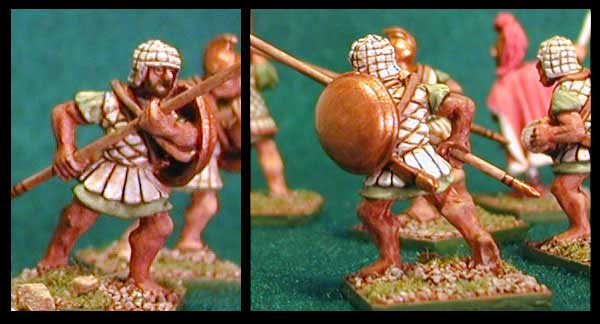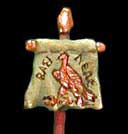


Ptolemaic
Soldiers
Last year (2003) was the year
of the Rise of Macedon, this year the focus is on the Successors and peripheral armies.
After the initial civil wars between Alexander's generals, the survivors founded three
powerful empires. In Macedon, the Antigonids were established under Antigonos Gonatas,
grandson of Antigonos Monopthalmus. In the east and Asia, Seleucus founded his own
dynasty, knocking out all opposition including Lysimachus. In Alexandria, Ptolemy
established a firm grip on the people and province and founded the longest lasting
Successor dynasty.
Recently I was lucky enough to get a few of the new 1st Corps Ptolemaic figures in 28mm. These are quite welcome as there has been a void in coverage of this empire's troops, especially the difficult to pin down Egyptian machimoi (the traditional Egyptian warrior class). Egypt was a area of constant revolt under the Persians, and the Ptolemaic army feared arming the native population as this would threaten their minority rule. Eventually the Ptolemies were put under great pressure by the Seleucids in Syria, and the vizier Sosibios raised and trained Egyptian phalangites during a lull in the war with Antiochus III.
At the the famous elephant battle at Raphia, the Ptolemaic army was able to defeat the Seleucid phalanx with their massive phalanx of levies, and turned back the Seleucid offensives temporarily. Later the Seleucids regrouped and conquered Syria and Palestine, as the predictable happened.... the Egyptian populace rose in rebellion in the delta, and at Thebes installing a "last Pharoah" with aid of the Meroitic Nubians in (206). The Ptolemies and their wealth, and mercenaries were able to eventually crush these revolts, but the Ptolemaic empire was on the decline, from within, as all the other dynasties crumbled to Rome.
Thanks to Phil Stirpe of 1st Corps for sharing these figures, I hope they inspire some to recreate this very different looking phalanx army.
 |
The 1st Corps
sample I received are a command group of three models, officer, drummer, and standard
bearer, and two phalangites. The standard was not provided in the samples so I added a old
one cannibalized from the bit box. These figures are typical of 1st Corps style, not
too big 28's, they will be a little smaller when compared to Foundry, Old Glory, or
Newline models. They had some cleaning issues and are cast from very hard metal,
making drilling and cutting some extra work. For example the model of the standard bearer
had his raised hand stuck onto his helmet, this made cutting away difficult and I ended up
with some mashed fingers on the hand. Other than that the pikes drilled through
clean as the hands were lined up well enough to guide them, this is always a concern as
unaligned hands makes for bending and further cutting.
|
 |
This is obvious the
most interesting figure of the release.... a machimoi phalangite wearing
quilted helmet and chest armor. There is really no description of what these
phalangites really looked like (in fact they might also have looked like the 'regular'
phalangite described below). However this is a cool interpretation based on a lot of
cross sources, for example the Egyptian troops that fought with and against Persia are
described as wearing quilted armor. The mercenary Greeks that campaigned in these revolts
also adopted a linothorax cut of this quilted material as well. So combining these
ideas with the Egyptian style headgear is not an outrageous assumption. I haven't
painted the shield design yet, as I'm waiting to finish a whole unit of these before I
decide on that. Green was selected as a tunic color because it is different looking
and there is some scant evidence for it.... I just like Green for Ptolemies for some
reason! Red would probably be less controversial.
|
 |
The machimoi
drummer has a nice gait to him, all these solders are leaning forward, ready for the push
of pikes! He shown as a native soldier wearing a kind of composite quilted corselet.
|
 |
The officer is typical of a Hellenistic general, he has iron armor, silvered, with gold tassels. The Romans copied the Hellenistic generals' appearance, that's why folks that watch your games will think your officers are Romans! This figure could be crafty Sosibios himself lending extra leadership to the levy phalanx at Raphia. This is a nice figure, albeit he appears a bit stocky, but then some of these iron corselets were made to withstand a shot from a bolt shooter in a siege. The cloak could also be green, if a high ranker like Sosibios, probably purple.
|
 |
The standard bearer wears a quilted corselet cut like a spolas or linothorax with ptruges (fingers). This may be the style of armor copied by the Greek general Iphicrates and introduced to Greece before the item of Alexander. It is unknown how common this armor type was as this kind of material rarely survives in archeological digs and there is very paltry visual evidence as well. The helmet is a typical high crested version of the Ascalon style, popular in both the Ptolemaic and Seleucid armies. The banner design is taken from a coin, it appears that the eagle is a typical Ptolemaic emblem.
|
 |
The central figure here is a regular phalangite of the settled Macedonian population, or a mercenary, or may just as well represent the machimoi. The photo at the top of the page shows the style of armor called the kotthubos and is illustrated in AMPW figure 38. Few models in 28mm capture this high waited style of corselet as well as this 1st Corps figure. I would only wish for a variant with greaves, and or boots as well, that would make this figure quite useful. Congrats on a nice new entry to the Successor ranks, hopefully the army lists will be out by the time the armies are collected and painted :) I look forward to more figures in this range, hopefully phalangites with raised pikes for variety, and maybe some cavalry, Arab, and Nubian auxiliaries to fill out the Galatians and other mercenaries that can be gathered form other manufacturers to fill out a Ptolemaic army.
|
You can order 1st Corps figures and the rest of their range can be seen at:
http://www.1stcorps.co.uk






Ptolemaic references:

Questions or Comments Email: Jeff@AncientBattles.com
05/20/07